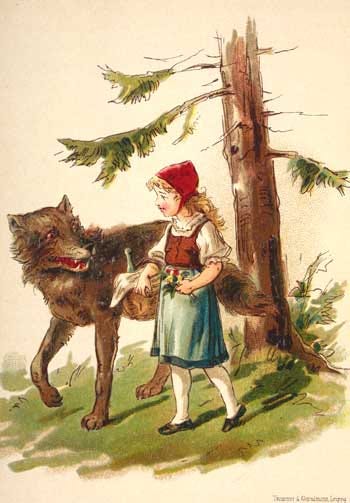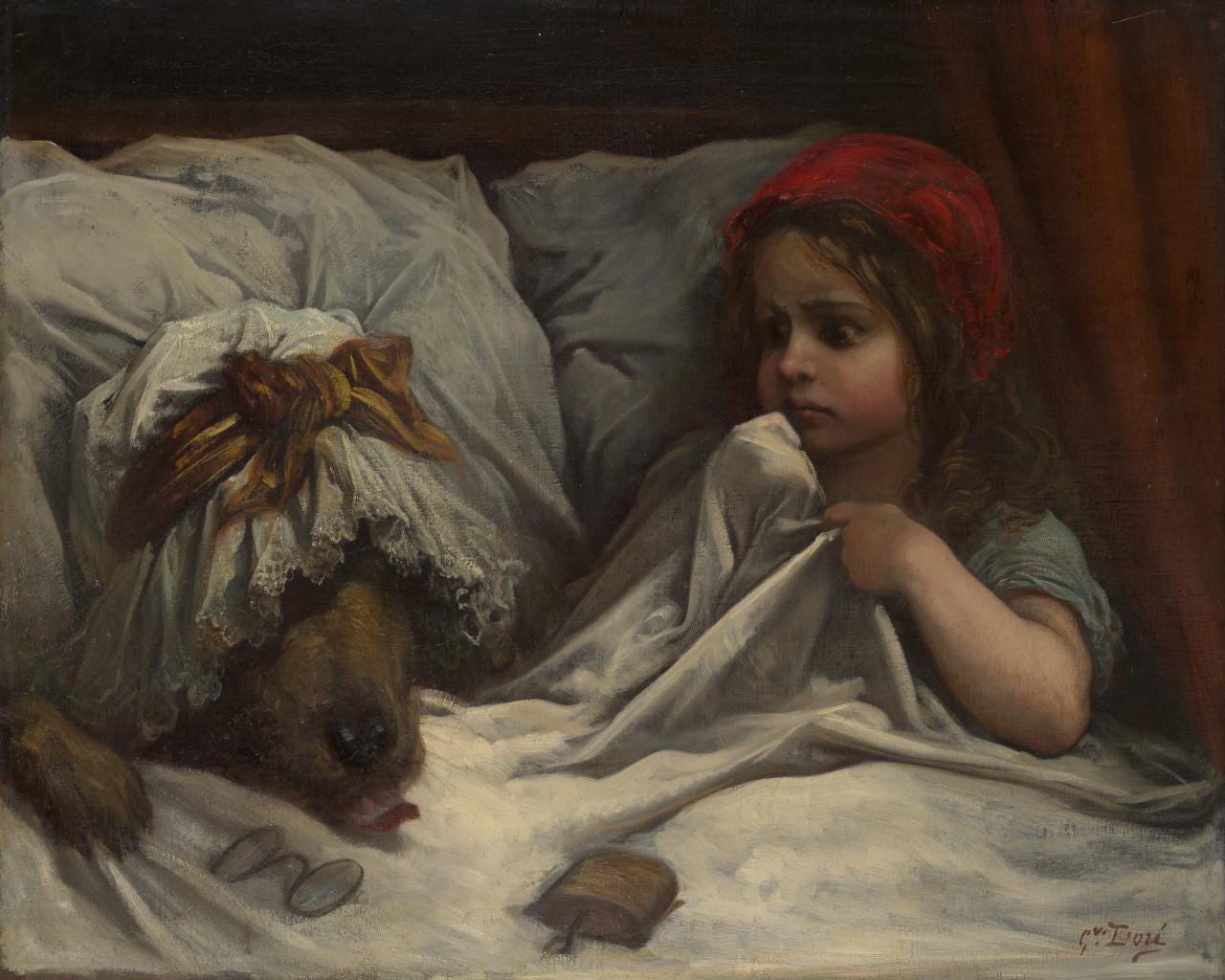Tale Told Twice: Little Red Riding Hood
An early version of the well-known tale paired with my own retelling
Welcome to the first installment of Tale Told Twice, in which I’ll share a fairy tale, along with a contemporary retelling of the same tale. There are a lot of authors out there doing really cool things with fairy tale retellings, and I want this to be a place where I can spotlight that work.
I thought there was no better way to kick off this series than with “Little Red Riding Hood,” probably the most well-known fairy tale—and one that has inspired hundreds, maybe even thousands, of retellings.
Everyone knows the story of Little Red, but you may not know that an earlier 1885 version of the tale (later recorded in 1951 by Perrault) exists called “The Story of Grandmother.” Like many other pre-1900’s fairy tales this one is full of violence, overt sexuality, and vulgarity. But, more importantly, it features a girl protagonist who is not stupid and naive, but clever, intuitive, and resourceful. She trusts her instincts and escapes the wolf on her own, rather than falling for the wolf’s tricks and having to be rescued by a huntsman.
Fairy tales were designed to entertain and amuse, of course, but these original oral tales were also designed to warn and instruct. This version of “Little Red Riding Hood” offers a very different message for girls than the one many of us know. “The Story of Grandmother” concedes that a girl may fall for a dangerous man, but it encourages her to trust her intuition. It tells girls they can—and must—get themselves out of unsafe situations as soon as they recognize danger. Isn’t that a much more useful message for girls than “don’t stray from the path and if you do, you better hope there’s a big strong man around to save you”? One teaches independence, the other compliance.
The Story of Grandmother
There was a woman who had made some bread. She said to her daughter: "Go carry this hot loaf and bottle of milk to your granny."
So the little girl departed. At the crossway she met bzou, the werewolf, who said to her:
"Where are you going?"
"I'm taking this hot loaf and bottle of milk to my granny."
"What path are you taking." said the werewolf, "the path of needles or the path of pins?"
"The path of needles," the little girl said.
"All right, then I'll take the path of pins."
The little girl entertained herself by gathering needles.
Meanwhile the werewolf arrived at the grandmother's house, killed her, and put some of her meat in the cupboard and a bottle of her blood on the shelf. The little girl arrived and knocked at the door.
"Push the door," said the werewolf, "It's barred by a piece of wet straw."
"Good day, granny. I've brought you a hot loaf of bread and a bottle of milk."
"Put it in the cupboard, my child. Take some of the meat which is inside and the bottle of wine on the shelf."
After she had eaten, there was a little cat which said: "Phooey!... A slut is she who eats the flesh and drinks the blood of her granny."
"Undress yourself, my child," the werewolf said, "And come lie down beside me."
"Where should I put my apron?"
"Throw it into the fire, my child, you won't be needing it any more."
And each time she asked where she should put all her other clothes, the bodice, the dress, the petticoat, the long stockings, the wolf responded: "Throw them into the fire, my child, you won't be needing them anymore."
When she laid herself down in the bed, the little girl said: "Oh granny, how hairy you are!"
"The better to keep myself warm, my child!"
"Oh granny, what big nails you have!"
"The better to scratch me with, my child!"
"Oh granny, what big shoulders you have!"
"The better to carry the firewood, my child!"
"Oh granny, what big ears you have!"
"The better to hear you with, my child!"
"Oh granny, what big nostrils you have!"
"The better to snuff my tobacco with, my child!"
"Oh granny, what a big mouth you have!"
"The better to eat you with, my child!"
"Oh granny, I have to go badly. Let me go outside."
"Do it in the bed, my child!"
"Oh no, granny, I want to go outside."
"All right, but make it quick."
The werewolf attached a woolen rope to her foot and let her go outside.
When the little girl was outside, she tied the end of the rope to a plum tree in the courtyard. The werewolf became impatient and said: "Are you making a load out there? Are you making a load?"
When he realized that nobody was answering him, he jumped out of bed and saw that the little girl had escaped. He followed her but arrived at her house just at the moment she entered.
Usually, for a retelling I will include a link and direct you to another author’s work, but for this first installment, I wanted to share a short retelling of my own, which tells this well-known tale from the perspective of the grandmother, focusing on how women can look out for—and save—each other.
The Seventh Ache
Like all women, I was born in the belly of the beast; I didn’t mind dying there.
That vice grip around my limbs, my life, was so familiar to me that I didn’t even dread the inevitable intestines. I felt I could anticipate the sensation—that constriction as I was pushed through someone else’s system. I might survive it. I had survived worse.
But I needn’t think of that now. For now, I was safely in the wolf’s stomach. And it was warm, and wet, and womb-like. A woodland squirrel floated by my left foot in a halo of green digestive acid. Berries, brambles, a brownie bumped my brow.
It was the brownie that worried me, jogged me from embryonic complacency. It looked like one of my granddaughter’s. Oh god. Even after being swallowed, a grandmother’s job is never finished.
Luckily, I knew a little about bodies. What they need—and what they can’t bear. If there was one thing I knew, it was ache. Inside the wolf, I sank deep inside myself, burrowing into all that pain, mining it. I excavated that first, twisted ache: marriage to a man I hated. The second: his death. The third: my isolation. The fourth: wanting him back, despising myself for it. The fifth: my daughter following in my footsteps. The sixth: the fear that hung over my heart like a shadow as I watched her give birth—watched my granddaughter slip, screaming, into this harsh world.
I gave that wolf the worst stomach ache he’d ever had. Until he was sick. Until he vomited my life onto the floor. Until I rose from the pile of bile, pulling a bramble from my hair, to stare into my granddaughter’s face.
At least, I could save her from the wolf.
Sound off in the comments with your opinion on “The Grandmother Story” and “The Seventh Ache.” What do we lose when we sanitize older, wilder tales? What can we gain by reclaiming them through retellings?
For more retellings of “Little Red Riding Hood” and other fairy tales, I recommend checking out the woman who invented fairy tale retellings, Angela Carter. She is a genius, and The Bloody Chamber remains one of my biggest writing inspirations. And don’t forget to tune in here every month for another Tale Told Twice. Up next month: “Blue Beard.”
“The Grandmother Story,” Jack Zipes, from Paul Delarue's "Les contes merveilleux de Perrault et la tradition populaire" Bulletin folklorique de I'lle-de-France, 1951.








this is so good omg
Wow! This is awesome!!!! I love it!!